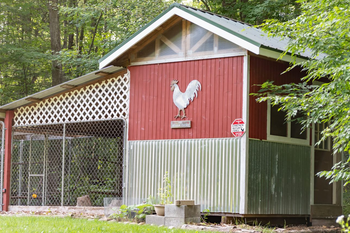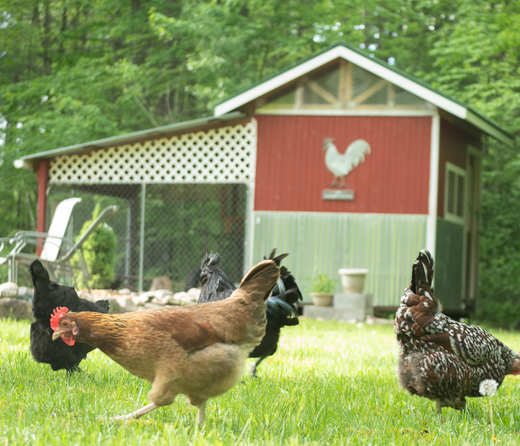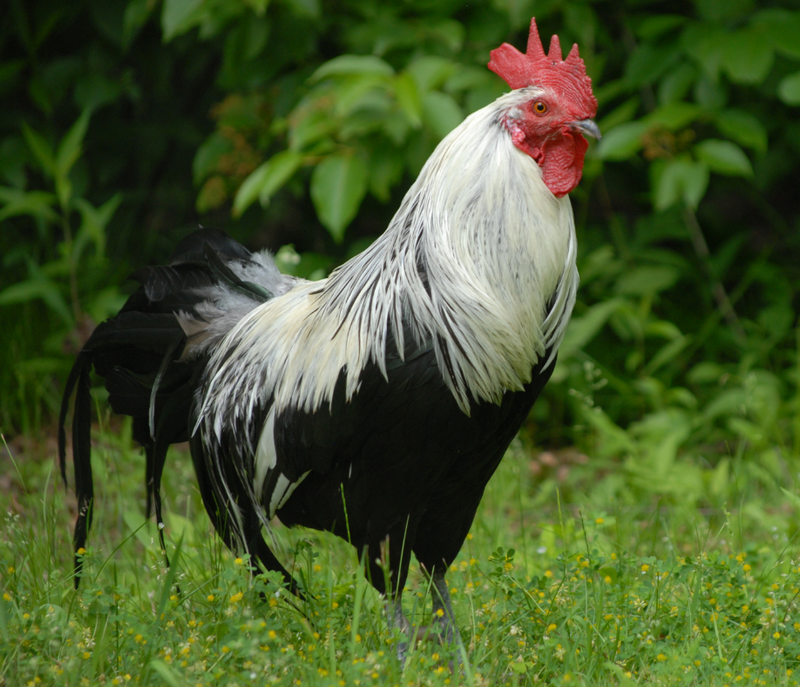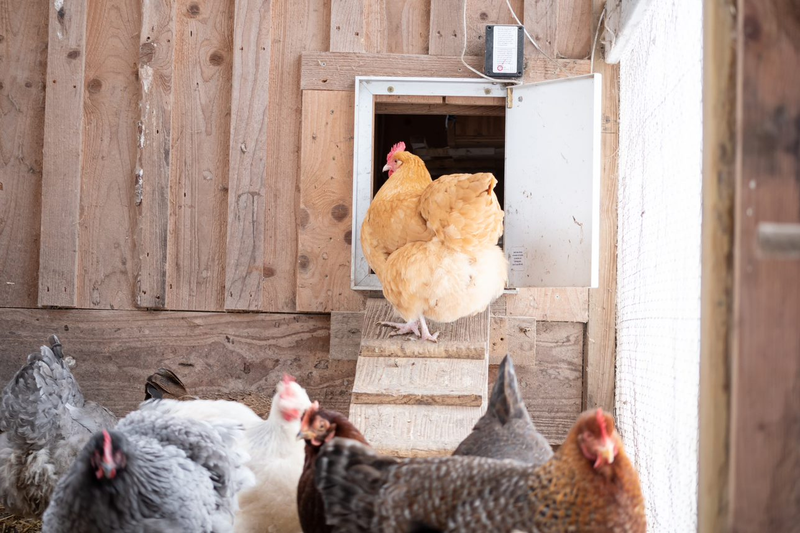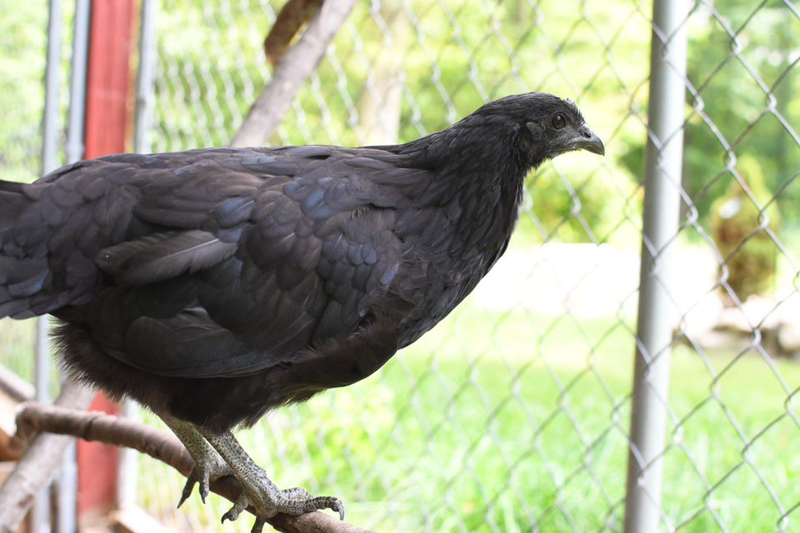What Should be Inside a Chicken Coop
Before you even bring home your baby chicks, you should have a plan in place for building their future home. Once your chicks are old enough, they will move out of the brooder and into a chicken coop. The chicken coop should provide your flock with everything they require to meet their daily and instinctual needs. This includes shelter, protection, food, water, a place to roost, a place to lay eggs, and a safe place to stretch their legs and interact no matter the weather! Raising a happy, healthy flock starts by having a safe and functional chicken coop ready for them to live in!
Just the Guidelines
With the world of design and architectural plans just a few clicks away, the volume of chicken coop designs has skyrocketed right along with the growing interest of raising backyard chickens. For as many flock owners as there are, there are just as many unique chicken coops! Chicken coops can be as fancy or as simple as you'd like. However, there are several key guidelines you must follow to make the chicken coop functional. This post is not intended to advise on any specific building plans or tell you how to build your coop. Our goal is to teach you what to look for as you shop for a coop, or ensure you have the guidelines to create and design your own amazing coop.
How to Set Up a Chicken Coop: The Groundwork
The placement of the chicken coop will affect the health and safety of your flock. Ideally, the chicken coop should be located in a shaded spot that is on high, level ground. You generally want to go with a more shaded location if you have the option. Chickens can handle cooler temperatures a lot easier than warmer temperatures. Placing the coop where it can stay shaded and cool during the summer is important for preventing heat related ailments with your flock. Shaded locations are often protected locations, which is helpful during the winter. Having a natural weather and wind-block near the coop will prevent any environmental stress if you live in a location that experiences varying weather conditions.
Along with location, you also need to consider the size of the chicken coop. Consider these important factors:
- How many chickens you are starting off with?
- How many chickens you plan to get in the future?
- Allow for chicken math (because it’s real!)
- Consider including storage space
On average, allow for 2-3 square feet of coop space per standard size chicken. Even if you are starting off with a small flock, always plan out a larger coop than you will need! For bantam chicken breeds (basically miniature chickens), allow for 1-2 square feet per bantam. You will want to take into consideration the amount of space that feeders, waterers, nesting boxes, and roosts will take up within the coop as well.

Having additional storage space in the chicken coop is not essential, however, it is helpful for storing feed and for keeping cleaning supplies handy and near the flock. Storage space within the coop will need to be kept clean and tidy to prevent any pests or predators from taking up residence in the storage space with a free buffet nearby (aka, your flock 😰). Aside from storing supplies, having extra space attached to the chicken area of the coop is helpful for preventing chickens from escaping, collecting eggs without entering the chicken area, and for cleaning the coop.
The materials that the chicken coop is made from should be strong and sturdy. Wood is an ideal building material since it can be built into a strong, sturdy, and long-lasting structure. The chicken coop building material should also be weather resistant and predator proof. Rain, wind, snow, hail, or sleet, nothing should affect the durability of your chicken coop! The coop materials should not be able to be chewed through, torn apart, or dug under. Predators can be determined creatures, and the coop must keep your flock safe!
If you’re designing your own coop, a few basic layout tips can help vastly optimize your overall setup. If you’re shopping for a coop, you can use these criteria to judge the best option:
- Usually, the chicken door should be located on the south facing side of the chicken coop.
- If designing a large coop, include a full-size door to make it easier for you to access the coop and clean the coop.
- Windows should be located on the east and west facing sides of the chicken coop.
- Avoid having the windows placed above or across from the roosts to prevent any drafts or winds from bothering the chickens while they sleep.
- Block off or avoid having any unintentional ledges, shelves, or rafters within the chicken area that the chickens may be tempted to roost (and poop) on.
- Avoid having dark corners in the coop.
- Design the coop with ease of cleaning in mind!
Roofing & Flooring
The chicken coop roof and floor should be built out of strong, sturdy materials, much like the overall chicken coop. Both the roof and the floor should be weather-proof and predator-proof. The roof should keep rain and other precipitation out of the chicken coop and it should also shed water to prevent any build-up of precipitation on the top of the coop. The floor of the chicken coop should be made from solid material. Having a solid floor versus a wire floor in the coop allows you to use a litter in the coop. Litter helps make coop cleaning easier, is more predator proof, and is healthiest for the chickens. The coop roof and floor should not allow any access points for predators to sneak through or under and enter the chicken coop.

Ventilation & Light
Adequate ventilation and light in the chicken coop are essential to the health of your flock. Ventilation allows for the old, stale air contained within the coop to be exchanged with fresh, oxygen laden air from the outdoors. Proper ventilation also keeps ammonia fumes from building up within the coop, a problem that can also be prevented by adequate coop cleaning.
You want the chicken coop to be well ventilated but without drafts. The difference between ventilation and drafts is a matter of air flow. Ventilation allows for air exchange whereas drafts are a one-way air current that often blow cold air into the coop.
Ways to maintain ventilation in your coop include:
- Install windows that can be opened or closed depending on the weather.
- Build air vents near the roof of the coop that allow for air exchange.
- Design your coop to include a cupola that allows for coop ventilation.
- Any open ventilation holes should be covered with ¼” hardwire cloth to keep out predators.
Having a well-lit chicken coop is also essential for both the health of your flock and to make cleaning and coop maintenance easier for you. You can use natural light, artificial light, or a combination of both. To achieve a well-lit coop with natural light, you should have plenty of large windows. If you live in a region that has cold winters, you will want to consider how you can partially insulate the large windows during the winter while still allowing in natural light. Artificial lighting is also an option if you install electricity out at the chicken coop or rig up a solar light system. LED rope lights are a great option as they are safe to use in the coop and provide a soft light that puts less strain on the hens.
Again, design plays a key factor in the success of your coop. A well-ventilated coop and well-lit coop can be achieved through a few thoughtful design considerations, such as windows. There are a few tips you should consider when installing windows in the chicken coop:
- Have windows on the east and west sides of the coop to maximize the amount of natural light that shines into the coop.
- Consider having windows that can be opened or closed depending on the temperature and weather.
- If the windows can’t be opened and closed, then have a method of insulating the windows for when you have to winterize the coop.
- Make sure the windows are predator-proof. Cover the inside of the windows with ¼” hardwire cloth to keep most predators out.

Nesting Boxes
For the laying flock, nesting boxes are an essential element in coop design! Hens like to lay their eggs in locations that appear safe, slightly dark, and have clean litter. This is exactly what the nesting boxes should achieve in your chicken coop. You should provide one nesting box for every 4-5 laying hens in your flock. Hens like to have choices when they are looking for a spot to lay their eggs. Even then, you will often find that all your hens will prefer to lay in the same box. This is a result of their nesting instinct, as it is natural for a hen to build up a clutch of eggs, even if they aren’t all her own, to sit on and incubate. Don’t worry- only broody hens will go through the process of incubating and hatching a clutch of eggs.
The nesting boxes should be the proper size for your hens while also being able to accommodate the largest hen in your flock. Here are some size standards to keep in mind:
- Large breed nesting box size- 14" wide x 14" high x 12" deep
- Medium breed nesting box size- 12" wide x 14" high x 12" deep
Place your nesting boxes within the chicken coop. If you design the boxes so that they can be accessed from outside of the coop, make sure the latch on the boxes is secure so that no predators can sneak in through the nesting boxes. However, it's easier to have the nesting boxes installed completely within the coop.
Line your nesting boxes with clean litter and have a rail running along the outside. The rail makes it easier for the hens to access the nesting boxes. It should be no further than 5” away from the nesting boxes to discourage the hens from using the rail as a roost. Ensure your nesting boxes are lower than the roosting bars in the coop. Chickens instinctually look for the highest place to roost (sleep) for the night. If they start roosting in the nesting boxes, it can lead to a host of unintended consequences. To discourage your hens from wanting to sleep in the nesting boxes, make sure they are lower than the roosting bars.
Roosts
Roosts are what chickens sleep on at night. Chickens instinctively look for someplace safe and high off the ground to perch for the night. The roosts in the chicken coop should be a safe place that appeals to your flock’s instinctual roosting habits.
Chicken Roost Designs
There are two common types of roosts to use in the chicken coop:
- ladder roosts- these roosts are staggered vertically, much like a ladder leaning up against a wall
- horizontal roosts- these are roosting bars that generally run across one side of the coop and are parallel to the coop wall
Ladder roosts give your flock the option of perching high or low, depending on the breed and weight of the bird. Horizontal roosts often make droppings management easier. If you have heavier breeds in your flock, you will want to make sure the roosts are not higher than 2-3 feet off the ground. Heavier breeds can have feet and leg issues if they are routinely jumping up and down from high roosts. For lighter, more agile breeds the roosts can be slightly higher off the ground since these breeds will want roost in higher places. Allow for 8-12 inches of roost space per chicken, and of course, allow for flock additions and chicken math to occur!
Roosts can be made from a variety of materials, as long as they are safe and provide good grip for the chickens. Two by four boards that have been sanded make for great roosting boards. Rough but sturdy tree branches will also work as roosting bars. Do not use dowels or other slippery, round materials. You want the roosts to have enough purchase for the chickens to get a good grip and not slip off, but you also want the roosts to be splinter free. Don’t use materials that could potentially cut or sliver off into a chicken’s foot. Roughly sanding down the roosts ever so often is a good idea for keeping the roosts safe and clean. 
Droppings Management System
Having a droppings management system in the chicken coop is not essential, but it sure helps with cleaning the coop! Chickens poop at night while they roost. That means every morning there will be a collection of droppings that needs to be removed so that no ammonia fumes build up within the coop. Installing a droppings management system below the roosts can make morning clean up go a lot faster and it can also prevent your flock from having to walk through the droppings every morning. A couple of popular droppings management systems include:
- Droppings boards- These boards are mounted about 4-5” below the roosts and extend about 6-7” beyond the roosts on either side. They catch the nightly droppings so that in the morning the poop just has to be scrapped off the board and into a bucket to be deposited in a compost pile.
- Poop slings- Slings are made from sturdy fabric and are slung below the roosts. The slings collect the nightly droppings and then are cleaned off in the morning.
- Poop trays- Poop trays are trays that are positioned below the roosts and lined with litter to make removing the nightly droppings easier in the morning. The trays just need to be dumped out and re-installed for the next night. It helps to have a hardwire or chicken wire covering fashioned over poop trays to keep the chickens from walking through the trays in the morning.
Droppings boards work well for horizontal roosting systems whereas poop slings and poop trays work well with ladder roosting systems.

Feeders and Waterers
Your flock’s feeder and waterer can either be kept inside the coop or outside in the enclosure that is attached to the chicken coop. If the feed and water is kept inside the coop, account for this space in your coop design. You must also be very careful about cleaning up spills. Spilled feed will attract rodents and predators. Spilled water will dampen the litter and provide a place for bacteria to grow.
If you keep the feed and water outside, you will want to at least bring the feeder in to a safe location every night. Predators will be attracted to chicken feed, which is something you want to avoid. Depending on how many chickens you are raising, you may need more than one feeder or waterer. Consider the location and how much space the feeder and water system will require in the coop.
How much space the feeder and water require may depend on the type of system you choose to use. Hanging systems are often the best choice for getting the most out of your coop space since they simply hang from the coop ceiling and don’t require additional floor space. However, free-standing systems can also be used, or you can create systems that mount right to the coop wall. Feeders and water systems should always be at back height to your shortest chicken. This height limits feed waste and helps keep both the feed and water clean. Whatever feeding and water system you choose to use, just make sure it is easy for the chickens to access, can’t be tipped over or jostled, and that it keeps the contents clean and free of debris.
Some popular chicken feeder and water systems include:
- Poultry water nipples- can be fashioned into a hanging system or a wall-mount system
- Bell feeders and waterers- can be hung or created into a free-standing system
- Homemade PVC feeder and waterers- can be made into hanging systems or free-standing systems
Doors
The doors of the chicken coop are pretty self-explanatory, but you should be aware that a chicken coop needs at least two doors: one for the chickens to use and one for you to use! The chicken door should lead from the chicken coop to the enclosure that is attached to the chicken coop. It should be large enough to accommodate your largest hen, but it does not need to be a full-size door. The chicken door may also need a ramp that leads down from the coop to the ground in the enclosure. The door that you use should be a full-size door so that you can come and go with ease as you clean and maintain the coop.
Any doors installed at the chicken coop should be predator proof and able to be latched securely. Screen doors can be used as long as they are installed with a storm door that must be closed every night to keep predators out. Latches used to close doors should be easy to use but too tricky for predators to figure out how to open.
The chicken door will need to be opened every morning and closed every evening after your flock has gone in to roost for the night. For even greater luxury, you may can consider investing in an automatic chicken door. These can be programmed to open and close at certain times or at dawn and dusk. Quality automatic chicken doors are easy to install, are safe for the chickens, and are predator proof.

Electricity
Another nonessential but helpful feature out at the coop is electricity. Having electricity installed out at the coop can be helpful for various reasons:
- If you live in cold regions, electricity allows you to use electric water heaters to keep water from freezing during the winter.
- Electricity gives you the option of supplying supplemental light during short winter days to encourage your hens to keep laying.
- It can also be very helpful for cleaning the coop and running electric appliances like a shop-vac or power washer.
Electricity that is installed out at the coop should be safe and hazard free. Keep electrical outlets out of the chicken area and any cords should be securely fastened down. The electricity should be properly installed, and all electrical safety measures should be followed. No open wires or outlets should be present in the chicken coop. Always follow any code requirements based on your location.
Enclosure
The final item to consider when building or designing a chicken coop is the enclosure. An ideal enclosure is attached to the chicken coop by a door, allowing your flock easy access to both spaces. A full-size door should also be installed in the enclosure so that you can easily enter and exit.
It’s important that any enclosure is both weather-proof and predator proof. This allows your flock to get safe exercise no matter the weather. It also helps prevent boredom and allows the chickens to participate in normal bird activities on a daily basis. You will find that your flock will spend a majority of their day outside in their enclosure, which helps keep the chicken coop cleaner.
The chicken coop enclosure should allow about 8-10 square feet of space per chicken. A spacious enclosure will pay off in the long run with preventing behavior issues, boosting flock health, and keeping the coop clean. The enclosure should be completely encased in a predator proof material. Some are better than others, but here is a few popular options:
- Chicken wire- Not entirely predator proof, but the cheapest option.
- Hardwire cloth (1/4”)- The most predator proof choice.
- Galvanized livestock fencing- Galvanized fencing is very predator proof but can allow access for smaller predators like weasels, snakes, and opossums.
- Poultry netting- Poultry netting is the least predator proof.
The chicken coop enclosure should be covered and have a well-draining litter on the ground. A covered enclosure allows for year-round daily use and protects against arial predators. A well-draining litter keeps the enclosure from getting too muddy or wet, which is essential for maintaining flock health. Having loose soil in the enclosure stimulates natural flock behaviors like dust bathing and foraging.
The enclosure can also be a great place to include entertainment features. Homemade perches, ramps, balance beams, swings, and other chicken toys can all be installed in the chicken coop enclosure to stimulate activity and prevent boredom.
The feeder and water can also be kept in the chicken coop enclosure during the day. Just make sure you bring the feeder inside every evening to avoid attracting predators.

Fun & Functional!
Make your chicken coop as fancy as you want it, just make sure the coop includes all the essential elements like roosts, nesting boxes, a feeding system, and a water system. By following these guidelines, you can be sure that your chicken coop is both functional and fun for you and your flock. A safe, secure chicken coop combined with a spacious, predator proof enclosure will make for a happy and healthy flock of chickens!





